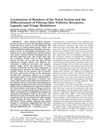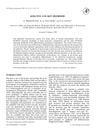Transdifferentiation of Corneal Epithelium: Evidence for a Linkage Between the Segregation of Epidermal Stem Cells and the Induction of Hair Follicles During Embryogenesis
January 2004
in “
The International Journal of Developmental Biology
”
TLDR Corneal cells can transform into hair-producing skin cells when exposed to certain signals.
The study explored the transdifferentiation of corneal epithelium into hair-bearing epidermis, highlighting the potential for transient amplifying (TA) cells to activate different genetic programs in response to changes in their fibroblast environment. It was found that adult central corneal cells could respond to embryonic dermis signals, leading to a decrease in K12 keratin expression and an increase in K5 expression, eventually forming hair follicles. This process involved the reprogramming of corneal TA cells to form epidermal cells, transitioning from a basal epithelial type to hair pegs and possibly hair stem cells. The findings confirmed the role of hair as a primary reservoir of epidermal stem cells and raised questions about the dermal messages involved in hair induction and stem cell specification.

